Recently, I told you about the 2017 return of the 1980s, cherry red, pointy-toed, slouch boot. Now I'd like to tell you about the 1970s return of the 1940s, cherry red, a-line, boxpleat skirt. It's no secret that most fashion is, to quote the song, "just a little bit of history repeating itself." You may not be into vintage fashion or fashion history, but, chances are, what you're wearing right now had a previous vogue, perhaps even before you were born. I find this kind of thing great fun. I hope you do too.
When discussing 1940s fashion, one is usually really talking about fashion from about 1939 to 1946: the war years. (Yes, I know the war ended in 1945, but The New Look didn't arrive until 1947.) Everything was rationed during the war, and this includes cloth. As a result, hemlines rose and skirts were worn closer to the body. It's true that straight-cut, pencil skirts would have used even less fabric than the a-line skirts that were in style, but, being form-fitting, they weren't as modest, and I'd guess that many women wouldn't have felt comfortable wearing them. In addition, in an era when many women were entering the work-force to help the war effort, I imagine that a-line skirts were simply more practical as they allowed for an ease of movement not afforded in a pencil skirt.
I don't know if boxpleats were added so often simply because they were attractive, or because they further increased ease of movement, or both, but they were common in women's attire at the time.
 |
| Sewing patterns from the 1970s |
1940s style in general experienced a resurgence in the 1970s. My own theory is that it's because these were both times in which women entered the workforce in uncommon numbers. The man-tailoring of women's suits in both eras might have made women feel that they were levelling the playing field between themselves and men.
In other ways, it's odd though because the 1940s were a time of great strife, deprivation, and hardship, while the 70s were known for their decadence and indulgence.
I can't think of a better example of this than the Pointer Sisters here, going all out with a 1940s look that is, at the same time, unmistakably 1970s. Maybe it's the boas, or the icy blue eye shadow, or the big hair, or the polyester. I don't have a problem with this.
Even those who slavishly reproduce looks from the past often make modern "mistakes." Maybe their eyebrows are overly defined, or their breasts are not girded as they would have been, or their shoes echoes one decade while their skirt echoes another. Some might condemn errors, and I certainly do when I see them in period movies, but, in real life, I think it's fine. I love retro and vintage style but I generally mix and match to my heart's content.
I knew this skirt would be perfect for my uses. The synthetic fabric would never pass as being from the 1940s, though it could probably pass for some of the stiff polyester of the 1970s. But the cut and colour are just right. I don't really like the belt as I find it adds bulk to my middle and limits my styling options, so I may eventually have it removed.
 |
| 1940s skirts |
Belts were worn with such skirts in both decades though.
I knew for sure my skirt would be great for both 40s and 70s retro looks, because the two decades shared so much in common, sartorially speaking. While I was posing for these photos with this car, people kept stopping and telling me how perfect my retro outfit was for the car.
They were certainly right about the colours! A little research tells me that this is a late 1930s model Chevrolet so it's entirely conceivable that a woman in the 40s, dressed as I am dressed, would have driven this very car. It was just total good fortune that its current owners (two women, a couple, I think) just happened to park outside of the cafe I was in while I was wearing this outfit!
But back to the skirt. I do love the look but it does lose its shape quickly...
... something The Andrews Sisters discovered too!
 |
| 1940s |
Still, when one is standing, this cut ...
... creates a wonderfully tailored, structured look ...
 |
| 1940s |
... even without the blazer that so often accompanied it. In researching for this post, I found these boxpleat, a-line skirts most often paired with blazers, making for a smart, sophisticated, no-nonsense suit perfect for the practical work-ethic of the war.
The 40s suit was another look shamelessly copied in the 1970s.
Often.
 |
| 1940s |
And why not?
A good thing is a good thing, whether it's worn in the 40s by The Andrews Sisters ...
... or in the 70s by Rhoda Morgenstern. She wore a lot of retro, 40s outfits, especially in the Mary Tyler-Moore spin-off, Rhoda.
But, just as I like to do, she put her own spin on things, in this case styling a bright red, 40s style blazer more casually than it would have been styled in the past.
I would love to own a 1940s blazer. In fact, I would love to own an entire, 1940s suit like these, especially in durable wool tweed, but I'd settle for a new, retro blazer ...
... but they are so hard to find in size Busty. Of all the clothing I outgrew when disability caused me to gain weight, I most miss a wool tweed blazer (the one a man told me wasn't sexy enough) that made my heart sing every time I wore it. I even had the matching skirt!
Of course, in the 1940s, as now, blazers were not always practical so it was also common to wear to see skirts worn with blouses.
I suspect this was a very common casual look, especially in warmer weather.
 |
| Lily Tomlin, Dolly Parton, and Jane Fonda, in 9 to 5 |
Yet again, it was adopted in the 1970s ...
 |
| Lily Tomlin, Dolly Parton, and Jane Fonda, in 9 to 5 |
... often with the addition a vest instead of blazer.
 |
| Mary Tyler-Moore |
In this 1970s outfit, we see a combination of two 1940s trends: blouses and sweaters worn with practical, a-line skirts.
In the 40s, I think sweaters -- pull-overs and cardigans, short-sleeved and long -- in place of blouses was considered more appropriate for youth and casual outfits, probably because they're more "body con," as we would say today.
To add to this "body con" look, they almost always had a flattering nipped-in waist ...
... which is where my cardigan comes in. V-necks were less common ...
... but not unheard of. (Now if only my sweater had little puffs at the shoulders. I do have a sweater like that that I can't wait to show you.)
Virtually all variations on these sweaters were copied in the 1970s. Here, in the early 70s, you see a whole look, complete with platform shoes ...
... taken directly from the 1940s ...
... and then carried forward -- by me -- into 2017.
 |
| Notice that the hat in this outfit is pulled straight from the 1920s, not the 1940s. |
A good thing is a good thing.
Now let's talk colours, shall we?
I find this combination of mustard yellow with ketchup red to be particularly bold and even counter-intuitive, but it worked then ...
 |
| Charlie's Angels, dressed to harmonize, one with the other |
... and then ...
 |
| Mary Tyler-Moore and Valerie Harper |
... and here ...
... and here. Perhaps the brilliant beauty of autumn leaves ...
... was the original inspiration for the combination.
As always, when something is in style in one aspect of design, it's in style for everything, like hair ornaments ...
 |
| 1940s in rare colour |
... exterior paint...
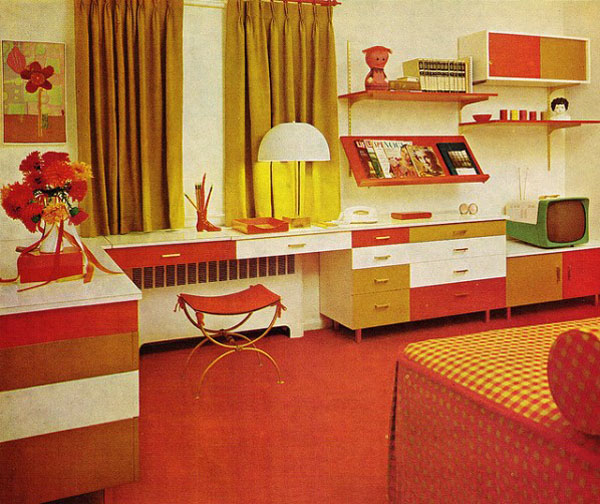 |
| 1970s |
... interior design ...
 |
| 1940s |
... and, of course ...
 |
| Mary Tyler-Moore |
... clothing.
Moving on to hair, I was going for a 1970s look with these barrettes. I know they're a 1970s thing because I'm old enough to remember wearing them as a girl.
When I think of this hair style and the 1970s, the first person I think of is Gilda Radner, whose hair was at least as wild as mine. (And, yes, she was Jewish, natch.) She was never known as a great follower of fashion ...
 |
| Mary Tyler-Moore, Cloris Leachman, and Valerie Harper |
... but women who were known for their fashion sense also wore their hair this way.
By pulling unruly curls off the face, and giving them a cascading effect, it's an incredibly easy way to both tame and show off hair that likes to misbehave. When I wore this outfit, several people complimented my hair, saying I'd gotten it "just right." I was confused by the compliments until I realized that they thought I'd put a lot of work into it, with curlers and irons and such. I felt almost guilty accepting their compliments, like I'd cheated or something.
Hair like mine was an absolute must-have in the 1940s, and often required a lot of work to achieve. Check out the careful sameness of these teenage girls' looks, hair included. It was usually parted on the side but, as the girl on the far right shows, a centre part (with or without clips) was acceptable, even amongst conformists.
From my look at old photos, I get the sense that this too was a style reserved mostly for youth, but it's 2017 and this 47 year old will do what she wants!
Overall, I think my outfit was a success ...
... and was a wonderful match for a golden, fall day.
But, if we're talking vintage style, where did I go wrong?
The shoes. I love these shoes! But they're not 1940s.
They're 1930s, and even 1920s.
This photo is a 1939 (accurate) prediction of the direction of fashion in the upcoming decade. Note that the shoes are nothing like mine.
 |
| Kate Jackson, Farrah Fawcett, and Jaclyn Smith |
No, my shoes are more like what was worn in the 1970s iteration of 1940s fashion. Take a look at Kate Jackson's shoes: t-strap, closed- toe, dainty ...
... much like mine than like anything worn in the 1940s.
The 1940s were all about the platform shoes, especially peep-toed sling-backs.
They were adopted with gusto in the early 1970s and, for a while, were a staple of the disco scene. (They also had a revival in the 1990s, if you'll recall.)
 |
| Cloris Leachman, Mary Tyler-Moore, Valerie Harper |
But even in the early 70s, women were wearing t-strap, mary-janes, like Rhoda's here ...
... which are almost a dead-ringer for these ones from the 1930s.
 |
| Debbie Harry |
As the 70s wore on, they got dantier ...
 |
| Debbie Harry |
... and strappier, often with a complicated, interwoven, almost lacy effect.
Not totally unlike mine.
 |
| Ginger Rogers |
They looked more like 1930s dancing shoes than like anything clunky from the 40s ...
 |
| Diana Ross |
... and they were enthusiastically embraced by disco devotees.
Sadly, my dancing days are long past, but I can still dress the part when I feel like it ...
... while indulging the little girl me who always insisted on buckled, leather mary-janes, and never wore runners (aka sneakers) until high school.
Now what about the sunglasses? Well, which ones? I wore these when I left the house ...
... but I found these babies while I was out and bought them on a whim.
They were a perfect, rockabilly match to the car. Total chance.
I do think big, dark sunglasses make flawed white skin look almost flawless. They take me from splotchy to porcelain.
Not so with lighter coloured sunglasses. I like these ones but I don't think they really worked with the outfit. They're definitely not even close to 1940s style, so I won't waste time on that.
Huge sunglasses were in in the 1970s.
Weirdly shaped sunglasses were in in the 1970s.
But even vaguely cat's-eye sunglasses, like both of my pairs, were not in.
This was the closest I could find and they're not very close. My guess is that people had finally grown weary of the ubiquitous cat's-eye glasses of the 50s and 60s and were ready to move on.
While we're talking about accessories, I'll tell you that I wasn't really thinking about decades or vintage or anything when I chose my jewelry for the day. I just wore what I felt like wearing. The 70s were definitely a time to pile on the gold, so that works, and I think my right-hand ring works really well for a 70s look. As you may know, I call it my Keith Richards ring. The bracelet belonged to my Jewish grandmother (as opposed to my Quaker one, whose pieces were costume, not real), and I suspect it was made in the 60s; if you know more, do let me know.
The earrings are just mine, me, and I'll wear them any time I want to, with whatever look I'm doing because... diamonds! I still haven't gotten a really great photo of them but I'll keep trying.
As I've said, slavish adherence to a retro look is not my bag, and if gleaming gold is what I'm in the mood for, gleaming gold is what I'll wear.
Because times have been tough, and the leaves were all yellow and gold, and, even more than giving a history lesson, I wanted to just play!
But the history lesson was fun too. I hope you agree.

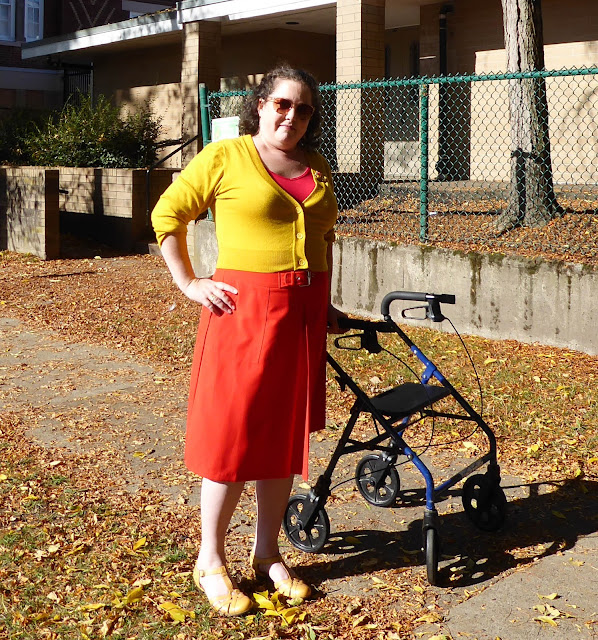






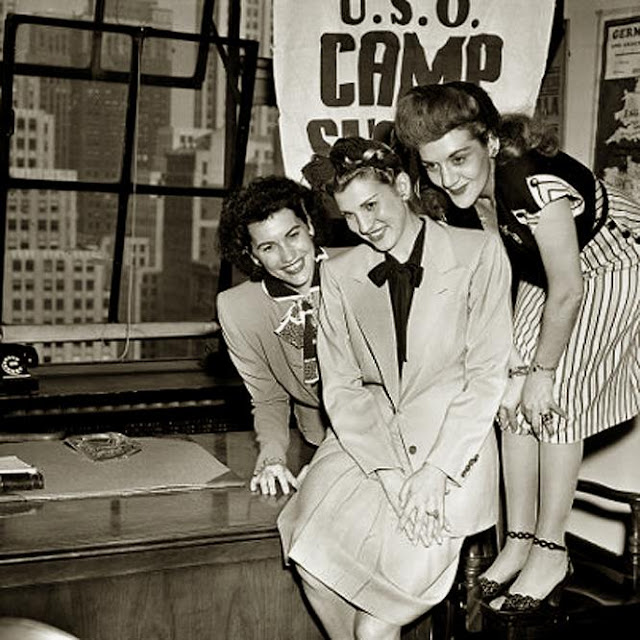

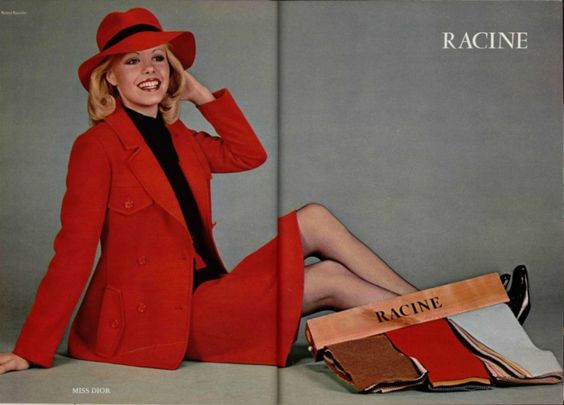






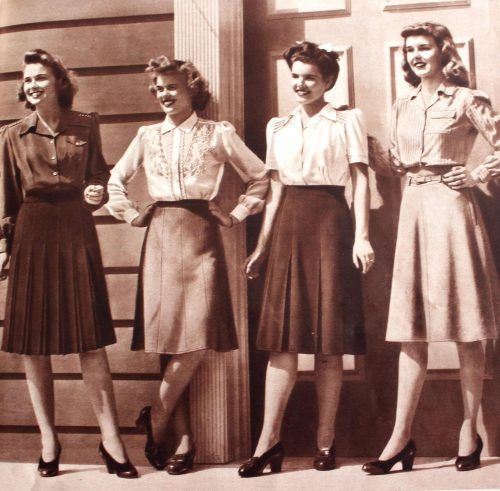












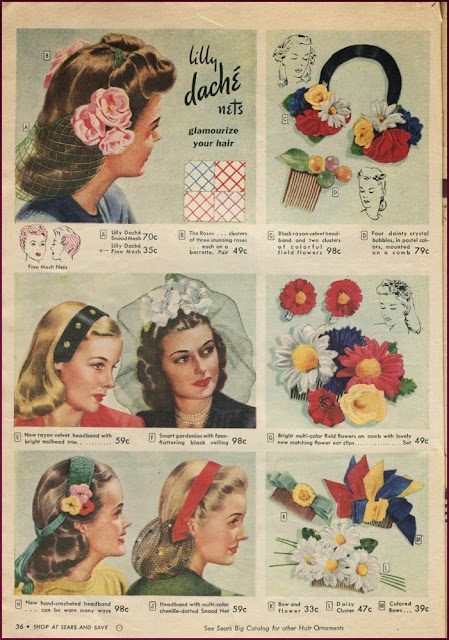
































Lovely, thank you
ReplyDeleteYou gave a great history of fashion lesson. I can't imagine how long this took you to prepare. I really enjoyed your article. patty
ReplyDeleteI LOVE this fashion blog! Very fun, thanks!
ReplyDeletei love this! really helped me find a good 70's does 40's hairstyle (mid-part + sort of victory rolls) for my curly hair to wear both up (while working in healthcare) and down. a super fun and well researched post! you look amazing. all the best to you, from 5 years later :D
ReplyDelete